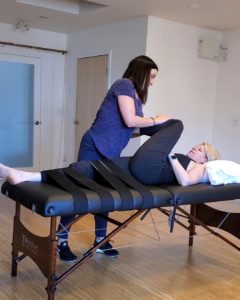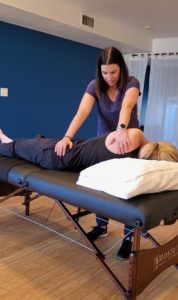Have you heard of Fascial Stretch Therapy (FST)?
I had not.
But I recently met Megan Sullivan, M.Sc., BA H.Kin Certified Athletic Therapist & Fascial Stretch Therapist of Ossum Wellness who introduced me to this full body approach that manipulates the body into a number of different stretches to target fascia. For my hour-long session with Megan I was instructed to wear comfy clothes. Her workspace in Bridgeland has a beautiful mural on the wall, ample natural light and tranquil blue paint. Her treatment table looks like a message table but with some straps and no “face holder”. I had just finished an hour ride and was looking forward to learning about FST. And quite honestly, just laying down for an hour!
It’s an interesting, and quite pleasant, experience unique from massage in that both therapist and client are actively moving the entire session. The treatment is relaxing and invigorating at the same time. I remained on my back the entire session. The session started with the hips where she did some traction and ‘joint play’ to get the synovial fluid moving. She then moved from the hips down: adductors, glutes, hamstrings, calves. She ended the lower body work with a side lying hip flexor and quad stretch.

The upper body starts similarly as she does some light traction of the arms to get the joint fluid moving prior to stretching. The rotator cuff muscles, latissimus dorsi muscle, mid back and forearm muscles are stretched here. Lastly, she ends the session with some neck stretches.

Again, gentle traction first before moving into the upper trap muscle and levator scapulae muscle. The next day I noticed a significant difference in my body when swimming. I felt “freer” in my traps and shoulders blades. Cool!

Megan describes FST this way:
“Fascial Stretch Therapy is an assisted stretching technique done on a massage table. The focus of FST is to improve the flexibility of the body’s fascia – the connective tissue that surrounds the muscles throughout the entire body. If the fascia is tight, then the muscle underneath it will also be tight. This is why it is so important to target the fascia when seeking improved flexibility. With reduced tension in the fascia, the muscles can also be stretched to achieve optimal range of motion.
FST addresses the joint and its respective joint capsule by using gentle traction to help alleviate adhesions and to stimulate joint lubrication. FST also targets several ranges of motion while putting each muscle through various stretching angles that are often difficult to achieve on your own. Our muscle fibres run in many different directions and therefore stretching in multiple different angles is important to account for this.
Importantly, many of our muscles experience overuse for instance our neck muscles, which have to hold up our head all day (or while riding a bike for many hours in aero position). And our glutes, which should ‘turn on’ with each step we take when walking, running, ascending stairs etc. It is important that these commonly over used muscles are stretched because not doing so may lead to injuries.”
Benefits of FST
- Improves range of motion
- Reduces the risk of injury
- Promotes body awareness
- Increases balance and symmetry of your body
- Reduces muscular soreness/muscular tension
- Improves posture, muscle function, circulation
- Improves energy
- Decreases joint compression/impingement
- Promotes quick post-race recovery
Megan’s thoughts on FST & triathletes:
“The commonly tight musculature in triathletes including shoulders, neck, hips and low back are addressed in FST. The traction applied to each joint prior to the stretch allows for some much-needed decompression. This can feel great especially after long training sessions. Also, traction helps alleviate the stress from holding static positions for long periods of time like after a long ride for example.
The rotator cuff muscles and pec muscles that can also become tight and/or injured from repetitive motions in swimming are also targeted. Further, these muscles around the shoulder can become chronically tight from rounded posture from lots of desk work and/or riding. When certain postures are held for long periods, these muscles become overused and FST helps improve the elasticity in these muscles through improved range of motion.”
FST is also beneficial pre and post race!
Commonly, individuals will book a session the week before and the week after their event: triathlon, running, cycling, swimming etc. This extra preparation before and after race day makes the added stress on the body more manageable. Also, FST aids in a faster recovery after strenuous exercise. During FST there is an increase in blood flow to the muscles which takes lactic acid and other metabolic byproducts (resulting from exercise) and circulates it throughout the body. The result is a quicker recovery process with less muscle soreness. This helps you get back to your regular training routine, post-race, faster!
Final thoughts:
Fascial Stretch Therapy can help individuals who have poor flexibility or mobility, as well as those who have chronic pain issues. FST compliments an active lifestyle, and also assists in injury prevention. If you are an athlete looking to improve your overall flexibility and want this race season to be your best one yet, consider giving FST a try. At Ossum Wellness, Megan offers 1-hour full body sessions or 30 minute half body sessions.
Learn more about what Megan offers on her website at www.ossumwellness.com